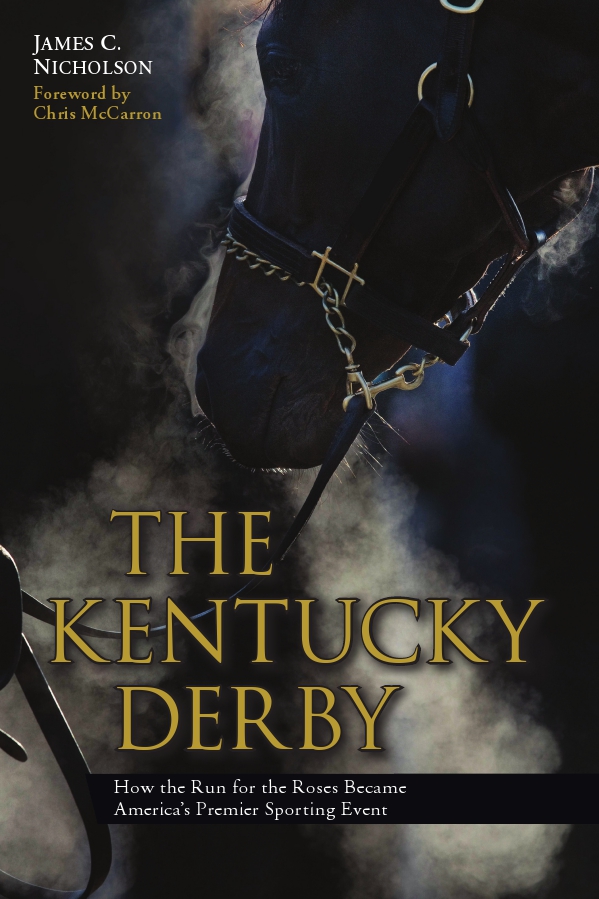Feature banner image - Dan Dry/Kentucky Derby
By Rebekah Tilley
The sharp taste of bourbon, the fluttering ladies hats, the first few bars of “My Old Kentucky Home,” pounding hooves, the refinement of the clubhouse box and the wild parties on the infield grass.
This is the Kentucky Derby.
In his recent book The Kentucky Derby: How the Run for the Roses Became America’s Premier Sporting Event, published by University Press of Kentucky, Department of History alumnus Dr. James Nicholson explores how the paradoxical reputation of Kentucky for lawlessness and gentility is reflected in and helped sustain “the most exciting two minutes in sports” despite significant cultural, political and economic changes over its 138 year history.
 “I tried to go back in time and see what Kentucky meant to people,” said Nicholson, who himself was raised on a thoroughbred farm close to the historic Keeneland Racetrack. “Why it was attractive. Why people would want to travel there for an event.”
“I tried to go back in time and see what Kentucky meant to people,” said Nicholson, who himself was raised on a thoroughbred farm close to the historic Keeneland Racetrack. “Why it was attractive. Why people would want to travel there for an event.”
In his book Nicholson teases out Kentucky’s dualistic identity that dates from the time of Daniel Boone and the mythological version of his exploits. Publications from that time painted Kentucky as a place on the edge of civilization but in the process of refinement by Boone and his fellow settlers.
In the early days of the Kentucky Derby, sensationalist journalistic coverage of Appalachian feuds and violence excited the American public of the late 1800s. Yet Nicholson found the real popularity of the Kentucky Derby ramped up at the turn of the 20th century as Kentucky as a place and Kentuckians as a people began to identify themselves as “southern.”
“When the Derby’s popularity started to explode it was aided by the idea that Kentucky - even though it never succeeded from the Union, even though it was never part of the Confederacy - was the place where the old South and its ideals and its vestiges lived,” explained Nicholson. “People would go to the Derby like people might go to MardiGras today. You could go to Louisville and experience ‘the South’ without traveling too far geographically and culturally.”
The Kentucky Derby is famous for being the longest continuously held sporting event in America and its connection to the past is an important part of its appeal today. Yet Nicholson argues the Derby’s ability to endure economic downturns, wars and cultural changes over its 138-year history has everything to do with Kentucky itself. “The appeal of the Kentucky Derby is based largely on its association with Kentucky and its own imagery and mythology,” said Nicholson. “Over the course of 130 some odd years, the tastes of Americans have changed and waxed and waned. The Derby’s status as American allowed it stay relevant and popular in the 60s and 70s when the idea of the ‘old south’ wasn’t in vogue. The good thing about the Derby is that it has this connection to this two-faced Kentucky. It’s refined and it’s wild.”
“The appeal of the Kentucky Derby is based largely on its association with Kentucky and its own imagery and mythology,” said Nicholson. “Over the course of 130 some odd years, the tastes of Americans have changed and waxed and waned. The Derby’s status as American allowed it stay relevant and popular in the 60s and 70s when the idea of the ‘old south’ wasn’t in vogue. The good thing about the Derby is that it has this connection to this two-faced Kentucky. It’s refined and it’s wild.”
That ability to have the best of both worlds, says Nicholson, is reflected in the Derby itself with the exclusive, posh Millionaires’ Row and accessible, rowdy infield. And it is this quality that will likely allow the Kentucky Derby to endure for another 138 years.
